
March 20, 2024 | 6 min read
Private infrastructure has amassed over $1 trillion in AUM in its relatively short history since the 1990s when private capital stepped in to fill government funding gaps and meet the broader trends of privatization.1 As many of the long-term assets for these essential services mature and approach the end of their closed-end fund life, infrastructure secondaries are coming of age with an increasing number of GPs turning to secondaries to extend the ownership of their high-quality assets for further development. For LPs facing lower distributions through much of 2022 and 2023, secondaries are offering an efficient solution for generating liquidity and/or rebalancing portfolios.
Infrastructure secondary volumes are rapidly growing but at the same time facing a shortage of infrastructure secondary capital. Given the current market dynamics, infrastructure secondary buyers have the opportunity to select from a growing pool of high-quality investments at favorable pricing and terms that are not trading in the traditional M&A market. For infrastructure investors not currently investing in secondaries this means potentially missing out on a wide swath of high-quality transactions that are no longer available through the direct infrastructure market. In this paper, we explore the growth and pricing trends that are taking shape across the infrastructure secondary market and the additive role these transactions can play in an infrastructure portfolio.
A deeper dive into infrastructure secondary growth
While still a nascent asset class relative to private equity secondaries, infrastructure secondaries are nearing an inflection point, growing at a 24.9% CAGR from 2015 – 2023, compared to a 7.1% CAGR for the infrastructure M&A market.2 With a record $15 billion of infrastructure secondaries closed or in the market in 2023, forecasts are projecting the market could reach more than $27 billion by 2027.3
Historical and projected infrastructure secondary volumes
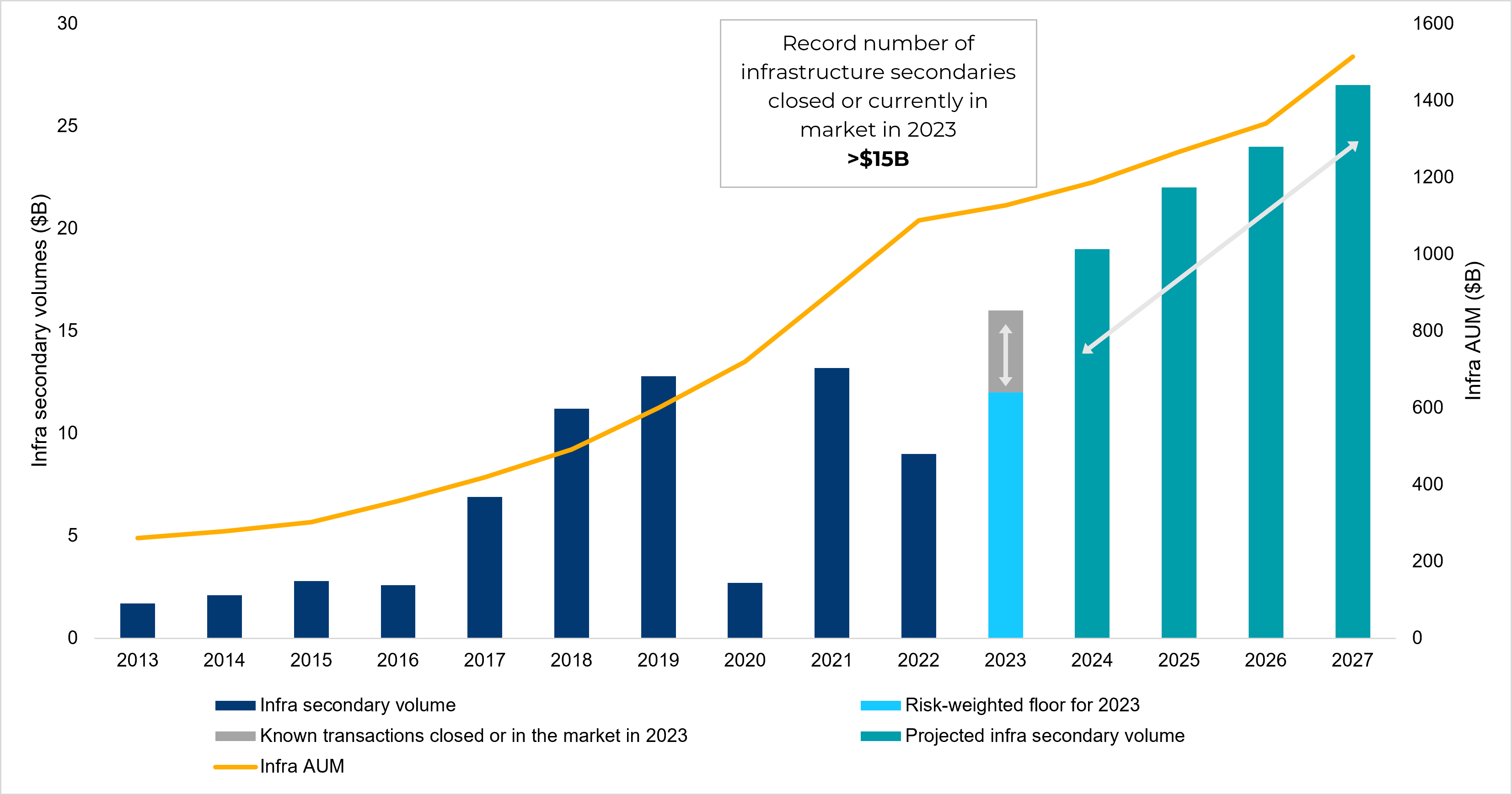
Source: Campbell Lutyens H2 2023 Infrastructure Market Report.
Infrastructure secondary capital overhang ratio
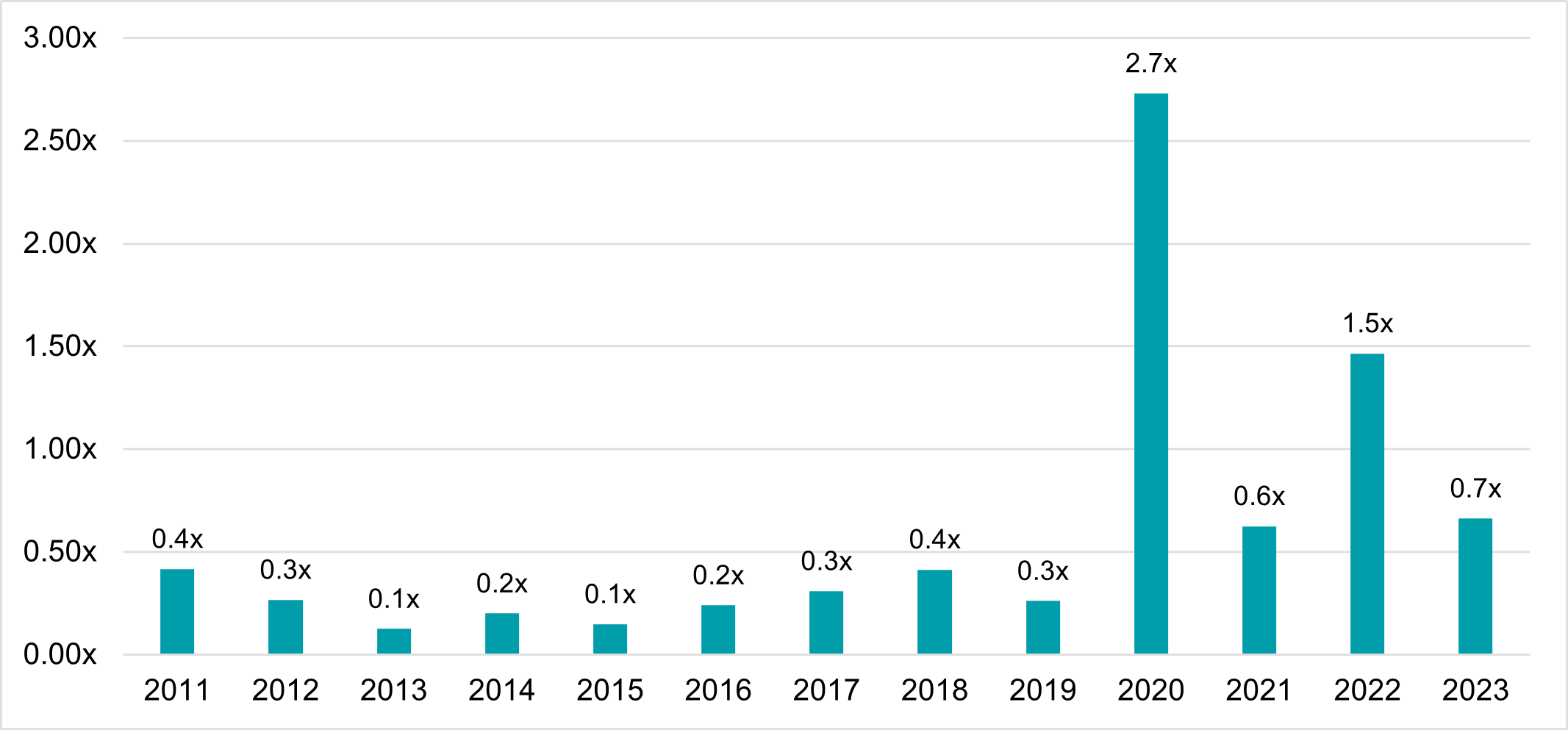
Source: Preqin & Campbell Lutyens H2 2023 Infrastructure Market Report. Capital overhang represents capital raised but not yet invested.
Infrastructure secondary pricing: Resilient but with buying opportunities
In the more volatile market backdrop over the last several years, infrastructure secondary pricing has broadly remained close to par or maintained single or low double-digit discounts. In particular, high-quality portfolios with large, diversified, well-known, blue-chip managers have tended to trade with narrower discounts as the underlying asset valuations are better known within the market. There is, however, more information asymmetry with respect to mid-market infrastructure funds, particularly when bottom-up underwriting is applied and GP valuation policies are taken into account, which can lead to advantageous pricing for secondary buyers. Additionally, given the limited supply of infrastructure secondary capital, secondary investors are often using deferrals, which can help improve headline pricing while also allowing secondary investors to deploy larger tickets using recycled capital.
In 2023 and 2024, there has been a notable softening in pricing. With higher interest rates and an increased cost of debt, there has been a concurrent higher cost associated with credit facility transactions that are often used by infrastructure secondary buyers. As the cost of those credit facilities approaches the cost of equity, there has been less aggressive pricing than was previously made possible using those lines, creating widening discounts for secondary buyers.
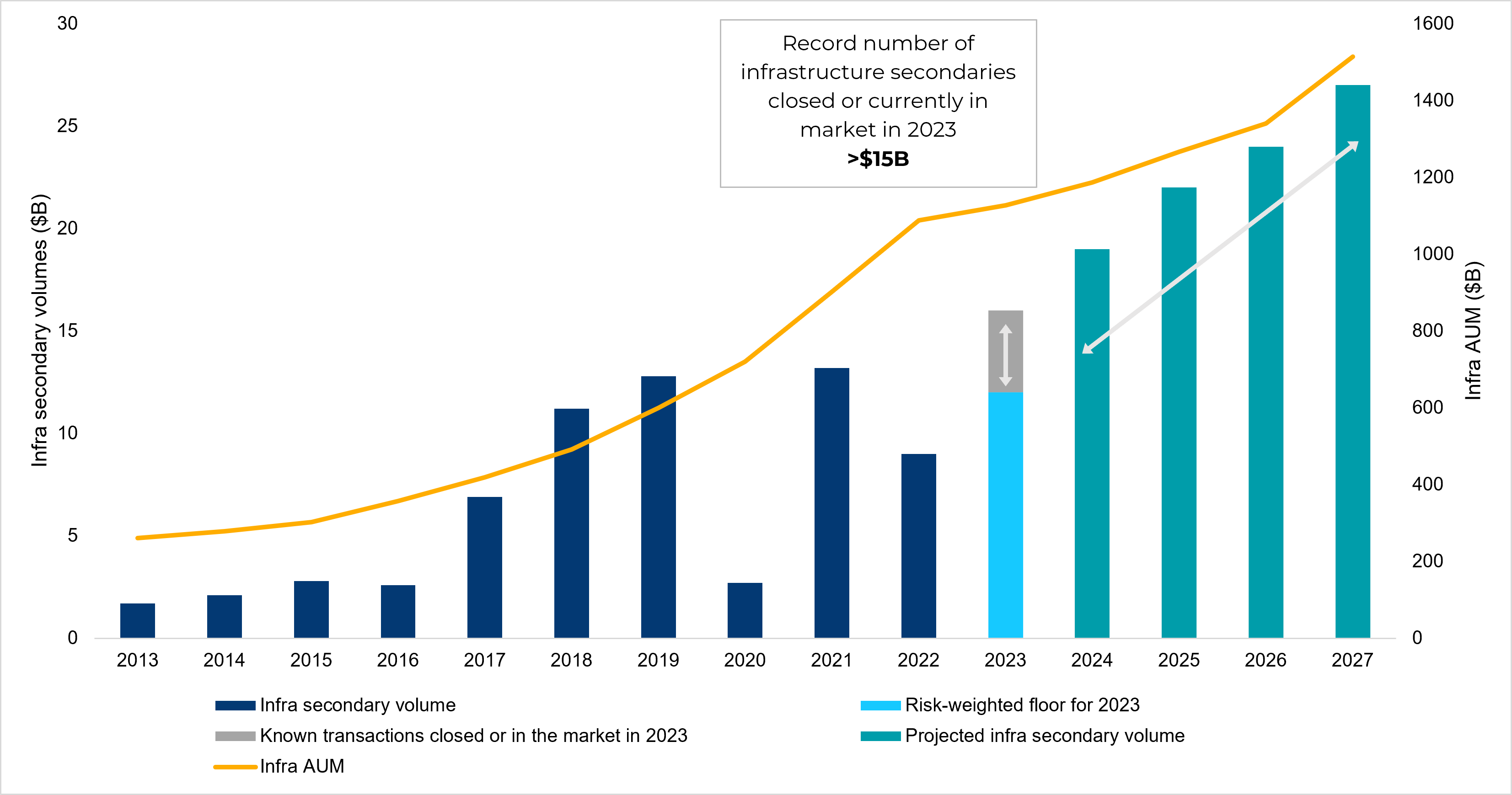
Infrastructure secondary pricing
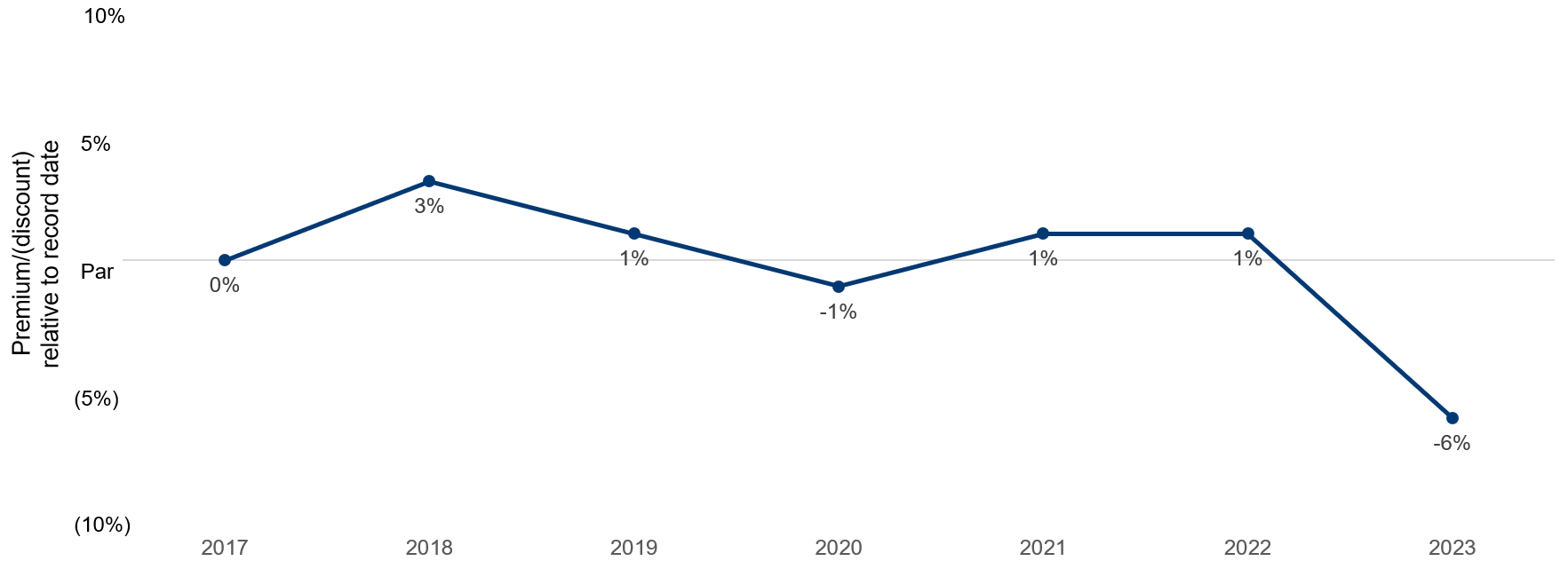
Source: Campbell Lutyens H2 2023 Infrastructure Market Report. Reflective of Campbell Lutyens market pricing received and transacted as of August 2023.
GP-led continuation vehicles in infrastructure
With economic uncertainty and an anemic M&A market persisting into 2024, there are fewer traditional exit routes for GPs and their portfolio companies. In 2022 and 2023, GP-led secondaries represented 68% and 56%, respectively, of infrastructure secondaries market volume.6 GP-led continuation vehicles have provided an efficient liquidity solution for GPs to extend the runway for some of their highest quality assets while also helping solve for some of their most timely issues, including capturing additional growth, maximizing exit options, aligning duration with shareholders, and raising additional capital for acquisitions or organic growth.
Assets that have transitioned risk profiles are another use case for GP-led continuation vehicles, and often these types of assets are only accessible through infrastructure secondary investments. For example, managers may target a value-add risk infrastructure profile on a development asset, however, once the development is complete and the asset is operational and transitioned to a core or core plus risk profile, it no longer fits the targeted risk profile. A GP-led continuation vehicle allows LPs that want to maintain exposure to the existing asset the opportunity to do so while offering other LPs the option to exit.
LP-led transactions in infrastructure
GP-led infrastructure secondary volumes
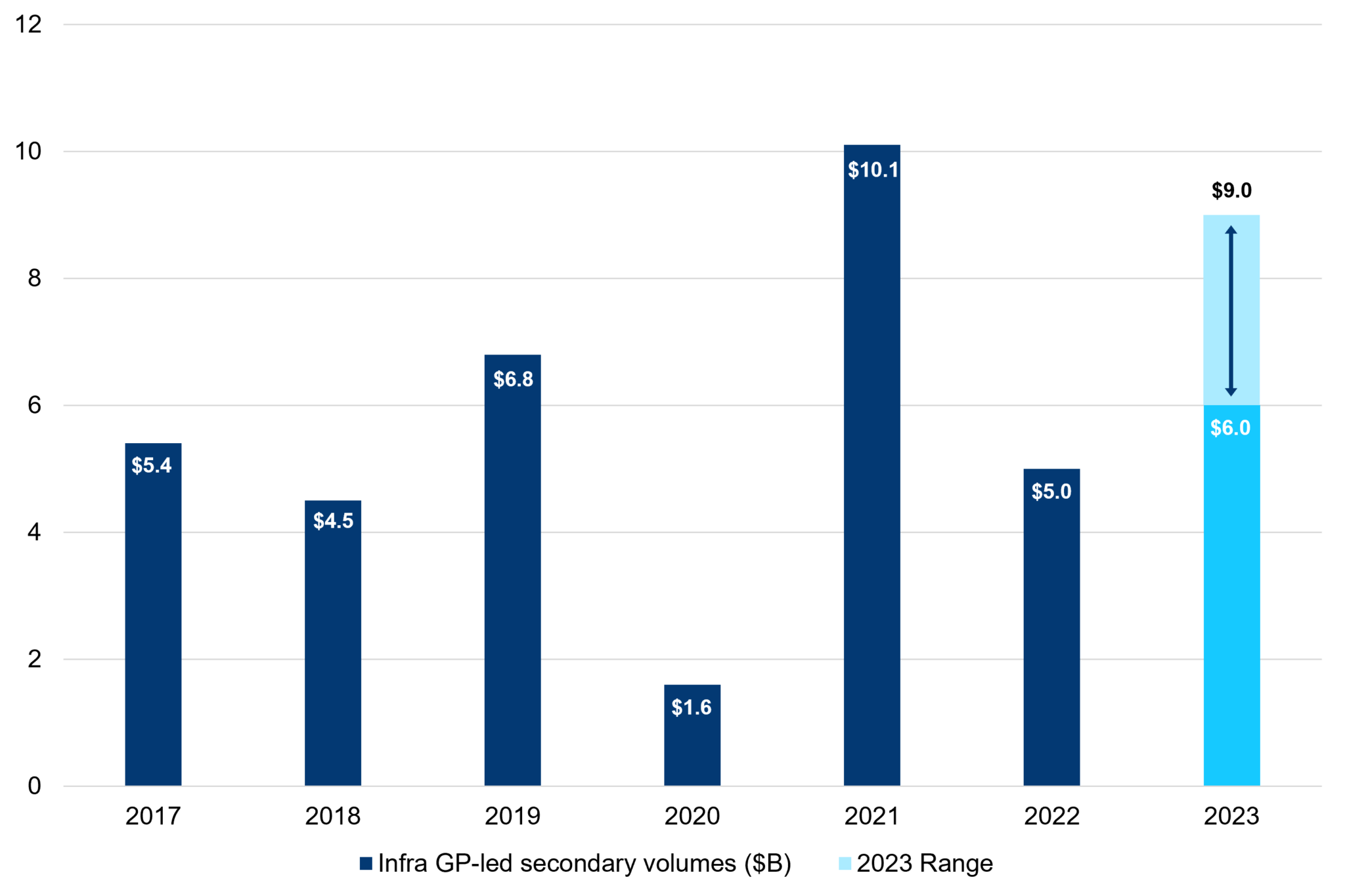
LP-led infrastructure secondary volumes
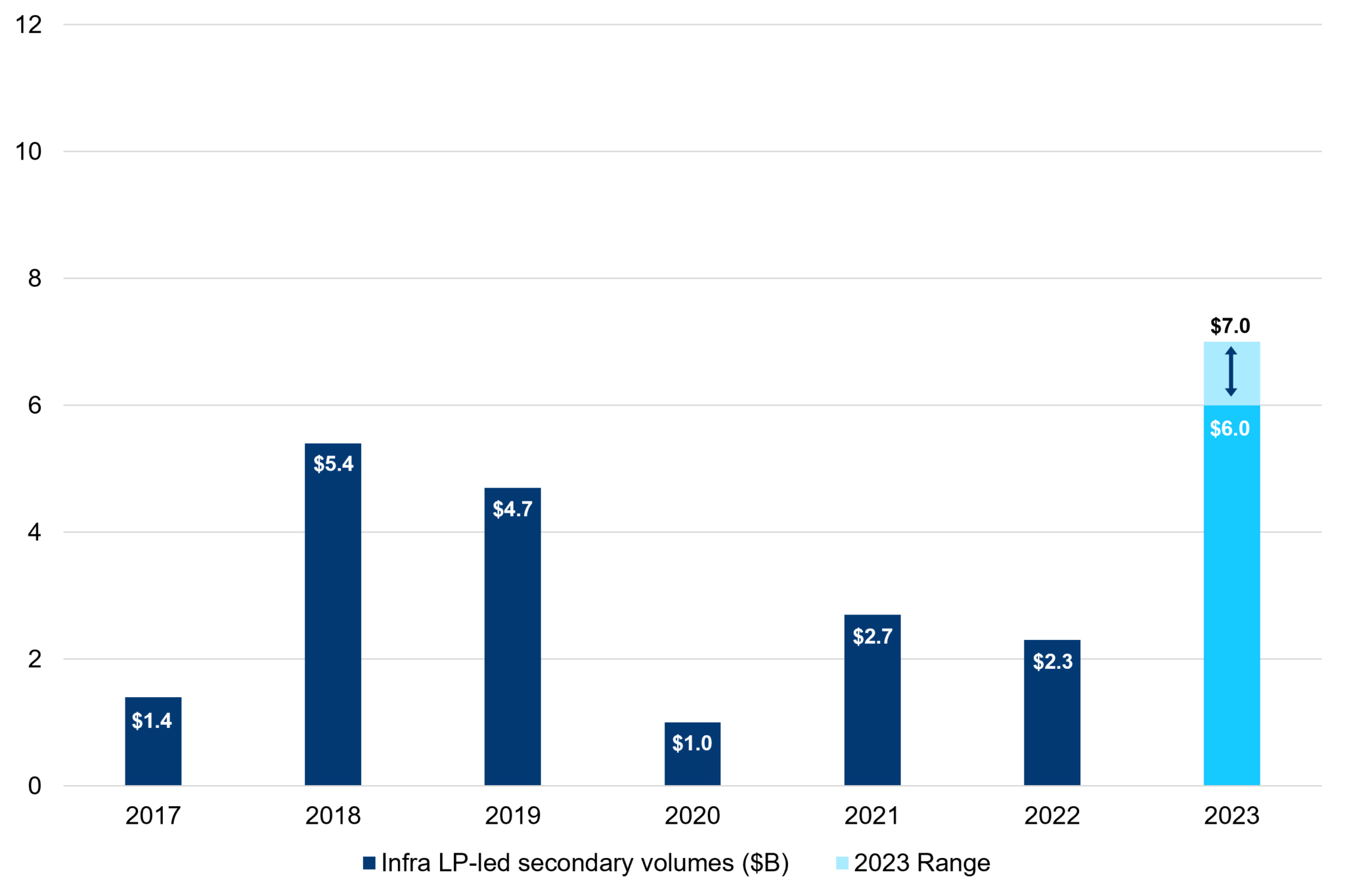
Source: Campbell Lutyens H2 2023 Infrastructure Market Report.
The role of secondaries in an infrastructure portfolio
Private equity investors have long relied on secondaries to achieve diversification, create enhanced liquidity, and provide differentiated access to top tier funds and GPs, but this practice is a more recent trend among infrastructure investors. Investing in infrastructure through the secondaries market can bring several distinct benefits to investors when constructing an infrastructure portfolio, including:
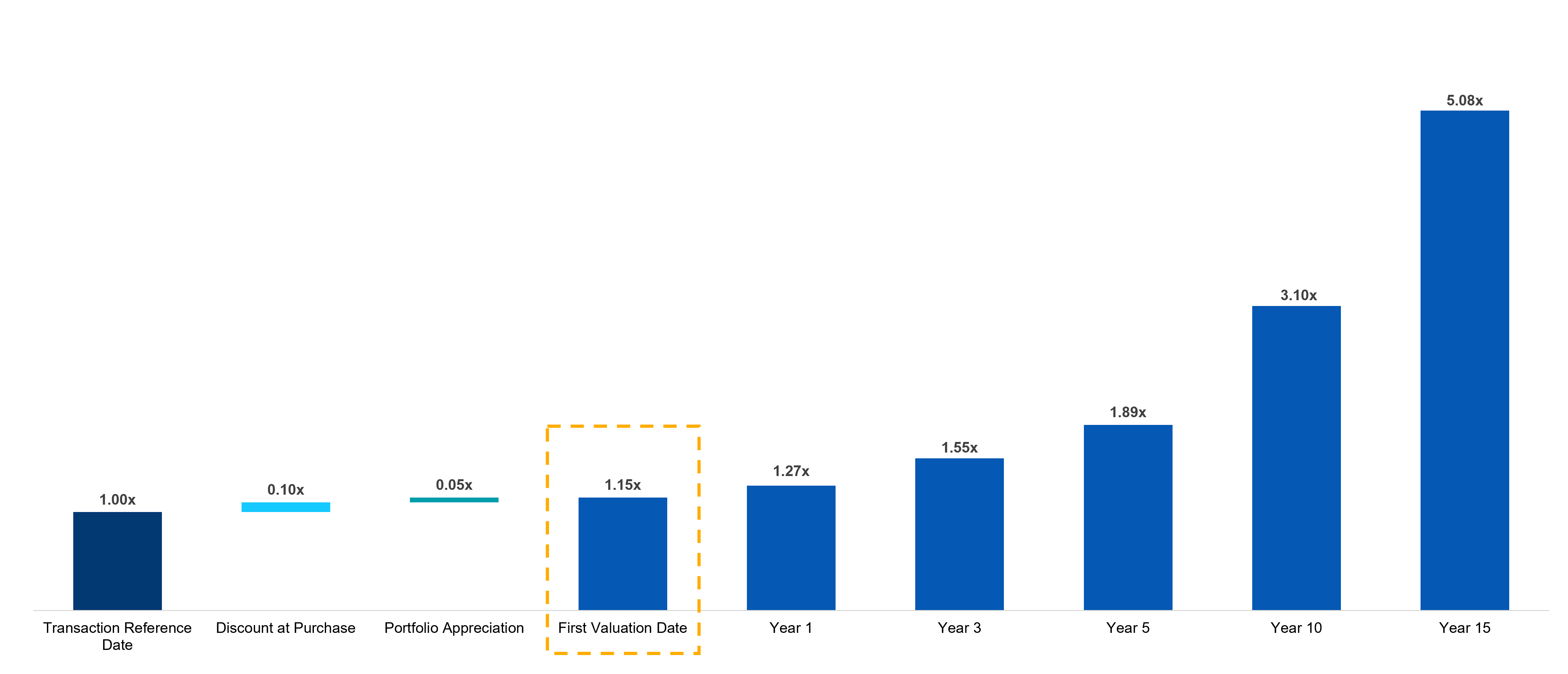
Illustrative infrastructure secondary uplift and returns over time 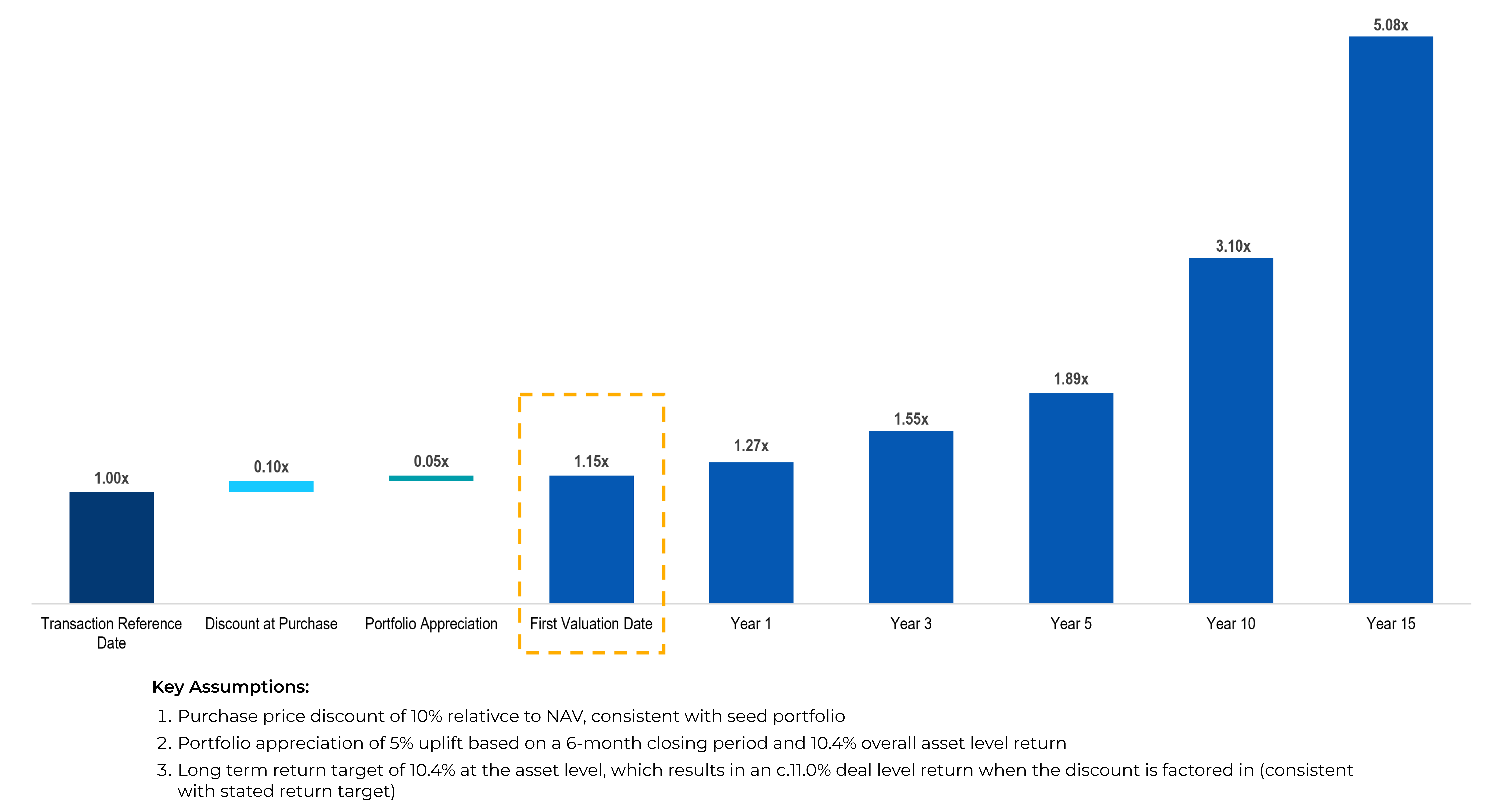
Source: HarbourVest, For illustrative purposes only. Past performance is not a reliable indicator of future results.When investing in infrastructure assets directly, many investors are often bidding on the same asset in a competitive M&A market. By investing in secondaries, investors have the opportunity to obtain similar diversified exposure but through differentiated sourcing, along with the opportunity to invest at a discount to NAV.
Infrastructure secondary funds generally represent well-established limited partnership interests that are typically between 60-90% funded. Based on the seasoned nature of the assets, an infrastructure secondary transaction can begin generating cash distributions as early as day one of an investment.
Secondary funds buy seasoned assets with an existing GP, which can limit the change of control and blind pool risks of direct investing. As a result, secondary funds can offer a narrower and more consistent band of returns compared to direct fund investments.
Unlike direct infrastructure funds where the IRR can be low or negative in the early years of a fund’s life, secondary funds can offer the potential for high initial IRRs driven by purchasing limited partnerships at a discount. Early high IRRs combined with early distributions typically mitigate the J-curve in secondary transactions.
Multi-asset secondaries or LP-led transactions provide investors the ability to achieve diversified access to a broad range of infrastructure assets across sectors, geographies, managers, and vintage years, which can help mitigate point-in-time risk.
Given the early distributions from infrastructure secondary investments, an investor is likely to only have 60-70% net out of pocket exposure (net capital calls as a percentage of limited partners’ commitments). Factors contributing to this include distributions offsetting early contributions and the use of deferral payments.
Infrastructure secondary funds generally represent well-established limited partnership interests that are typically between 60-90% funded. Based on the seasoned nature of the assets, an infrastructure secondary transaction can begin generating cash distributions as early as day one of an investment.
Lower return dispersion based on the seasoned nature of assets
Secondary funds buy seasoned assets with an existing GP, which can limit the change of control and blind pool risks of direct investing. As a result, secondary funds can offer a narrower and more consistent band of returns compared to direct fund investments.
J-curve mitigation
Unlike direct infrastructure funds where the IRR is low or negative in the early years of a fund’s life, secondary funds can offer the potential for high initial IRRs driven by purchasing limited partnerships at a discount. Early high IRRs combined with early distributions typically mitigate the J-curve in secondary transactions.
Multi asset secondaries offer diversification
Multi-asset secondaries or LP-led transactions provide investors the ability to achieve diversified access to a broad range of infrastructure assets across sectors, geographies, managers, and vintage years, which can help mitigate point-in-time risk.
Strong liquidity and self-funding profile
Given the early distributions from infrastructure secondary investments, an investor is likely to only have 60-70% net out of pocket exposure (net capital calls as a percentage of limited partners’ commitments). Factors contributing to this include distributions offsetting early contributions and the use of deferral payments.
Key takeaways
Investors are increasingly allocating to infrastructure secondaries as they seek the benefits of diversification, favorable cash flow characteristics, compelling risk adjusted returns, and J-curve mitigation. Infrastructure secondary investments can play a valuable role in both nascent and mature portfolios alike.
- Infrastructure secondary volumes are projected to rise rapidly, benefiting from strong secular tailwinds and a maturation of the asset class.
- Infrastructure secondaries provide investors the opportunity to gain access to marquee assets that are not available in the M&A market along with the opportunity to quickly scale a diversified infrastructure allocation at favorable pricing and terms.
- The shortage of secondary capital has created a tremendous opportunity for infrastructure secondary buyers to acquire high-quality and de-risked investments at a discount to fair value.
Would you like to discuss infrastructure secondaries and the developing role they can play in a portfolio?
- Preqin 2024 Global Infrastructure Report.
- Source: Inframation –Infrastructure M&A transaction; Campbell Lutyens – Infrastructure Secondary Volume.
- Source: Campbell Lutyens H2 2023 Infrastructure Market Report. Assumes a 1.7% average turnover of secondaries to infrastructure AUM.
- Preqin, 2023 Preqin Global Infrastructure Report.
- Campbell Lutyens H2 2023 Infrastructure Market Report and Preqin. Based on dry powder and near-term fundraising as reported by Preqin as of June 2023 relative to average annual deal volume from 2018-2023F. Levered assumes 20% leverage ratio on dry powder. For example, if just 2% of total infrastructure AUM (~$27 billion) were to seek liquidity in the secondary market, there is a clear shortage of capital with just $10.6 billion of dry powder available for investing.
- Campbell Lutyens H2 2023 Infrastructure Market Report.
- HarbourVest, based on analysis of private equity secondary and private equity 2000-2019 vintage funds from Preqin’s 2,000+ private equity funds which includes 193 private equity secondary funds.
HarbourVest Partners, LLC is a registered investment adviser under the Investment Advisers Act of 1940. This material is solely for informational purposes and should not be viewed as a current or past recommendation or an offer to sell or the solicitation to buy securities or adopt any investment strategy. The opinions expressed herein represent the current, good faith views of the author(s) at the time of publication, are not definitive investment advice, and should not be relied upon as such. This material has been developed internally and/or obtained from sources believed to be reliable; however, HarbourVest does not guarantee the accuracy, adequacy or completeness of such information. There is no assurance that any events or projections will occur, and outcomes may be significantly different than the opinions shown here. This information, including any projections concerning financial market performance, is based on current market conditions, which will fluctuate and may be superseded by subsequent market events or for other reasons. The information contained herein must be kept strictly confidential and may not be reproduced or redistributed in any format without the express written approval of HarbourVest.




